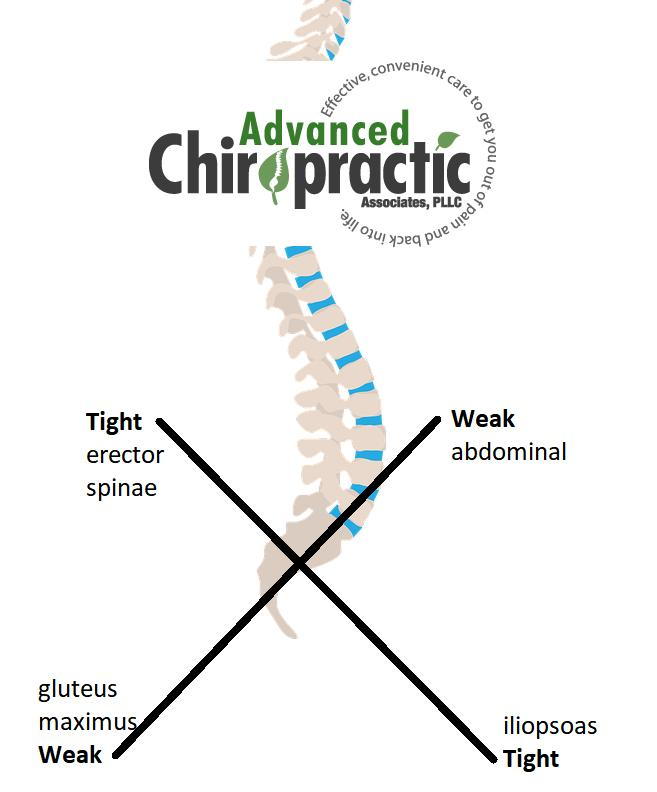Lower Crossed Syndrome Revealed | Common Symptoms and Proven Treatments

- posted: Jul. 30, 2018
Many times, in life it can be tempting to reach for a “quick fix”; a fast acting, temporary solution that generally does more damage than good. If you are looking for an actual resolution, you may just need to prove yourself! Prove yourself meaning: put in the time and effort that it takes to solve the root of the issue.
If we don’t give our-complete-selves to our goals, do we really want to reach the outcome?
All this especially applies to your health and the condition of your body.
What is Lower Crossed Syndrome?
Lower crossed syndrome is a condition that causes muscular dysfunction in the lower part of your body. This happens when some of the muscles throughout this lower section of your body are too weak while others are too tight. These tight and weak muscles form a crisscross, or X shaped, pattern.
The tight, overused line of muscles in lower crossed syndrome are the thoracolumbar extensors (erector spinae) and the hip flexors (iliopsoas). The weak and underused muscles in the other crossing line are the abdominals and gluteus maximus.
Where does Lower Crossed Syndrome Come From?
Lower Crossed Syndrome is very common! It is often associated with the slightly more common upper crossed syndrome. There are many ways and lifestyles where this lower crossed condition form.
- An inactive lifestyle
- Sometimes, even genetics
- Improper technique when exercising or strength training
- Sitting, especially with poor posture, for long periods of time
- Participating often in sports and activities where you do not use the muscles involved evenly
What does Lower Crossed Syndrome look like?
To really understand this condition, we must be aware of the symptoms and sign. Some of the causes we discussed in the last section are actually also symptoms of this syndrome- like poor posture and improper exercise techniques. This can turn lower crossed syndrome into something of a vicious cycle.
Here are some more symptoms of this condition:
- Sway back
- Tilted pelvis
- Budging abdomen
- Lower back pain or injury
- Poor physical performance
- Knee pain or injury such as hyperextension
- Osteoarthritis and degenerative joint disease
Lower Crossed Syndrome Treatments
Since lower crossed syndrome is a neuromuscular dysfunction, chiropractic is a great option for treatment. Not only that, this condition is tied to issues with the joints in your lower back, sacrum, and hips- which are ideally treated through chiropractic!
Your chiropractor helps to get some good motion in those joints. This helps your muscles get a healthy stretch and will allow the weak muscles to naturally regain some strength! Once those weak lower crossed muscles start strengthening, you are well on your way to healing this condition.
Exercises that target and strengthen these weak muscles are also very important. Doing your therapies at home is essential in the quick healing of lower crossed syndrome.
Since poor exercise technique and selection will make this syndrome worse, it is important that you ask a professional, like the chiropractors at Advanced Chiropractic Associates in Knoxville, TN, what therapy you should be using and only do them at home when your professional gives you the green light.
There may be some pain or discomfort through the beginning stages of healing lower crossed syndrome, that is ok! Start off slow and easy- and make sure to stick through it so that you can get back to a healthy back and a fuller life!
Do you or a loved one suffer from lower crossed syndrome or any of the symptoms that we talked about in this article? If so, contact your chiropractor to start your healing journey, today! The doctors at Knoxville Tennessee’s very own Advanced Chiropractic Associates are enthused to assist you throughout the entire process. There is no better time to start than now! Schedule an appointment online, over the phone, or even in person.
Advanced Chiropractic Associates, PLLC
7349 Chapman Hwy
Knoxville, TN 37920
865-579-6500
About the Author
Kali S. Garcia is a natural health enthusiast. As the owner and author of MamaTea Social, she feels compelled to heal and the cold hard facts. Connect with her on Facebook.
References
Chaléat-Valayer, et al. “Sagittal Spino-Pelvic Alignment in Chronic Low Back Pain.” European Spine Journal, Suppl, no. 5, 20 Sept. 2011, pp. 634–40., doi:10.1007/s00586-011-1931-2.
Garnas, Eirik. “Lower Crossed Syndrome: 6 Steps to Fix Anterior Pelvic Tilt and Swayback Posture.” Darwinian Medicine, 19 Dec. 2015, darwinian-medicine.com/lower-crossed-syndrome-6-steps-to-fix-anterior-pelvic-tilt-and-swayback-posture/.
Kim, Deokju, et al. “Effect of an Exercise Program for Posture Correction on Musculoskeletal Pain.” Journal of Physical Therapy Science, vol. 27, no. 6, 30 June 2015, pp. 1791–1794., doi:10.1589/jpts.27.1791.
“Lower Cross Syndrome.” Fredericksburg Chiropractic, fredericksburgchiropractic.com/home-therapy/lower-cross-syndrome/.
Scannell, and McGill. “Lumbar Posture—Should It, and Can It, Be Modified? A Study of Passive Tissue Stiffness and Lumbar Position During Activities of Daily Living.” Physical Therapy, vol. 83, no. 10, Oct. 2003, pp. 907–917., doi:10.1093/ptj/83.10.907.
Smith, Anne, et al. “Classification of Sagittal Thoraco-Lumbo-Pelvic Alignment of the Adolescent Spine in Standing and Its Relationship to Low Back Pain.” Spine, vol. 33, no. 19, 1 Sept. 2008, pp. 2101–2107., doi:10.1097/brs.0b013e31817ec3b0.
Location
Advanced Chiropractic Associates, PLLC
7349 Chapman Hwy
Knoxville, TN 37920, US
Office Hours
7:30 am - 1:00 pm
2:30 pm - 6:00 pm
7:30 am- 12:00 pm
Closed
7:30 am - 1:00 pm
2:30 pm - 7:00 pm
7:30 am - 1:00 pm
2:30 pm - 6:00 pm
Closed
Closed
Closed
Closed
Closed
Closed

